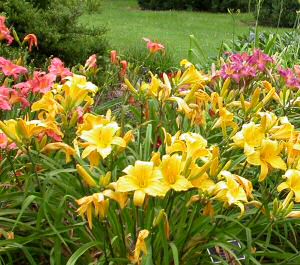
Day lilies belong to the genus Hemerocallis and are not true lilies. Some of the newer varieties have flowers that open in the evening and remain open until the evening of the following day. Many of these night blooming plants are delightfully fragrant.

Each day lily plant produces an abundance of flower buds that open over a long period of time.
There are many varieties, a wide range of flower colours, and the flowers continue during the heat of the summer.
Day lilies are useful in the perennial flower border, planted in large masses, or as a ground cover on slopes, where they form a dense mat in just a few years. They usually grow between one to four feet in height and produce numerous flower buds that are showy over a long period. Daylilies are hardy perennials.
Site and Soil

Day lilies grow best in full sun, they will tolerate light shade, but flower best with a minimum of six hours of direct sun.
Light shade during the hottest part of the day keeps the flowers fresh.
They should not be planted near trees and shrubs that are likely to compete for moisture and nutrients.
Although day lilies are adaptable to most soils, they do best in a slightly acidic, moist soil that is high in organic matter and well drained.
Planting
Day lilies can be planted almost any time the soil can be worked. Dig the soil deeply before planting. Work in well-rooted manure or compost to increase organic matter. Apply fertilizer based on a soil test. Dig a hole large enough for the roots without bending or crowding them.
The best time to transplant or divide plants is early spring or immediately after flowering. Plants divided in the spring may not bloom the same summer.
- Divisions should have two to three stems or fans of leaves with all roots attached. Make divisions by digging the entire plant and gently pulling the fans apart.
- Cut the foliage back, leaving only five or six inches.
- Place the plant in the soil so the crown (the portion where the stem and root meets) is one inch below the ground line.
- Water thoroughly after planting.
- A winter mulch of straw or shredded leaves helps protect against winter damage for plants that are not fully established.
- Day lilies are vigorous growers and can be divided every three to four years.
How to plant a day lily properly.

In early spring, before growth starts, remove the dead foliage from the previous year’s growth and any weeds. A summer mulch helps to reduce the task of weeding. Perennial grasses can be difficult to eradicate if they become established within the clumps.
Although day lilies tolerate drought, they perform best in moist, but well-drained soils.
One inch of water weekly is ideal, more frequent watering may be necessary on sandy soils.
Remove seed pods after bloom to prevent seed production. Plants producing seed are likely to have fewer flowers the following year.
Insect control measures usually are not necessary. Aphids sometimes feed on the flower buds. These pests can be controlled with insecticidal soaps or a repeated strong spray of water.
Annual fertilization may be helpful in producing more flowers. A spring application of manure or compost is beneficial each year.
Cultivars
More than 35,000 daylilies have been named, officially registered, and marketed. Many newly developed plants are introduced annually.
Daylilies were traditionally plants that stopped growing and became dormant throughout the winter, but today there are semi-evergreen and evergreen cultivars.
 Established daylily clumps often produce 200–400 flowers in a season. Bloom time extends from early to late summer. Each plant blooms for 30–40 days. With the large number of cultivars available, it is possible to have continuous bloom throughout the summer.
Established daylily clumps often produce 200–400 flowers in a season. Bloom time extends from early to late summer. Each plant blooms for 30–40 days. With the large number of cultivars available, it is possible to have continuous bloom throughout the summer.
Daylily flowers come in many colours, shades, and colour combinations.
Some are very full and round, others have wide petals with ruffled edges and borders. Others are spidery in shape; doubles have double the number of petals and sepals.
Day lilies are regional performers which means they grow well only in certain parts of the country. For this reason, you should purchase daylilies from a local nursery.
